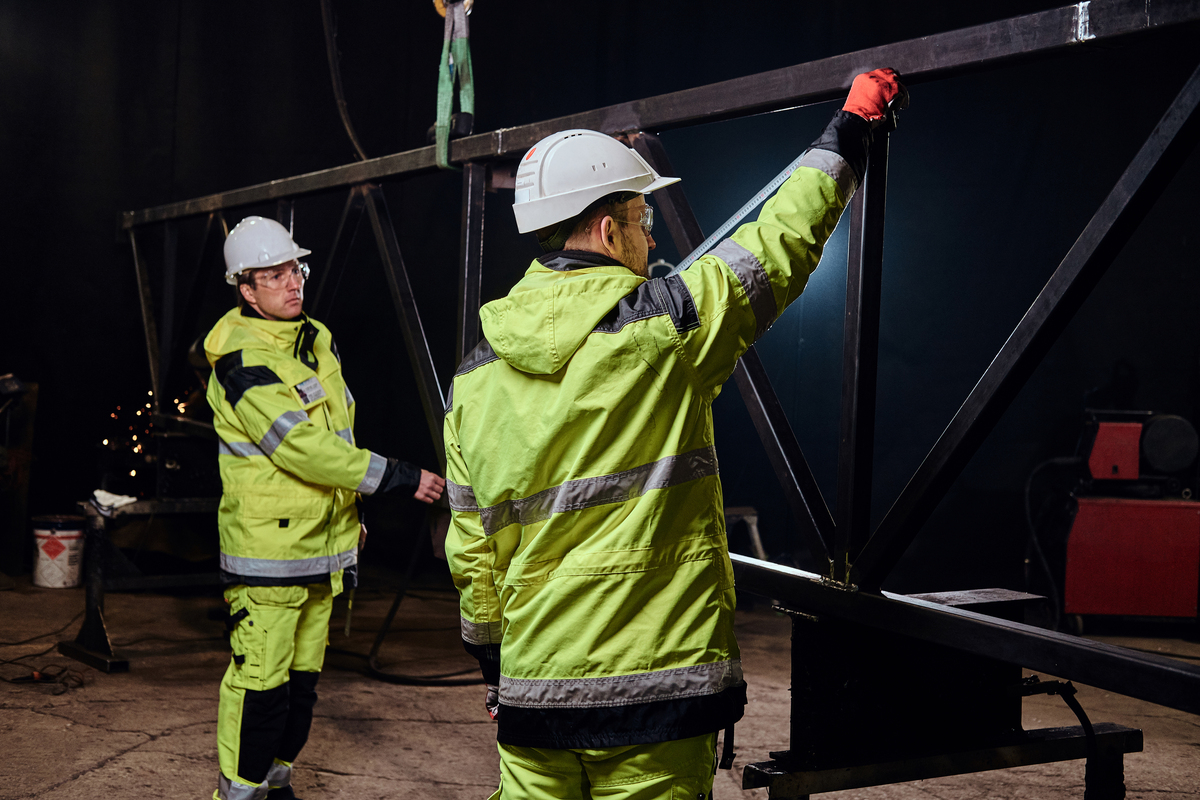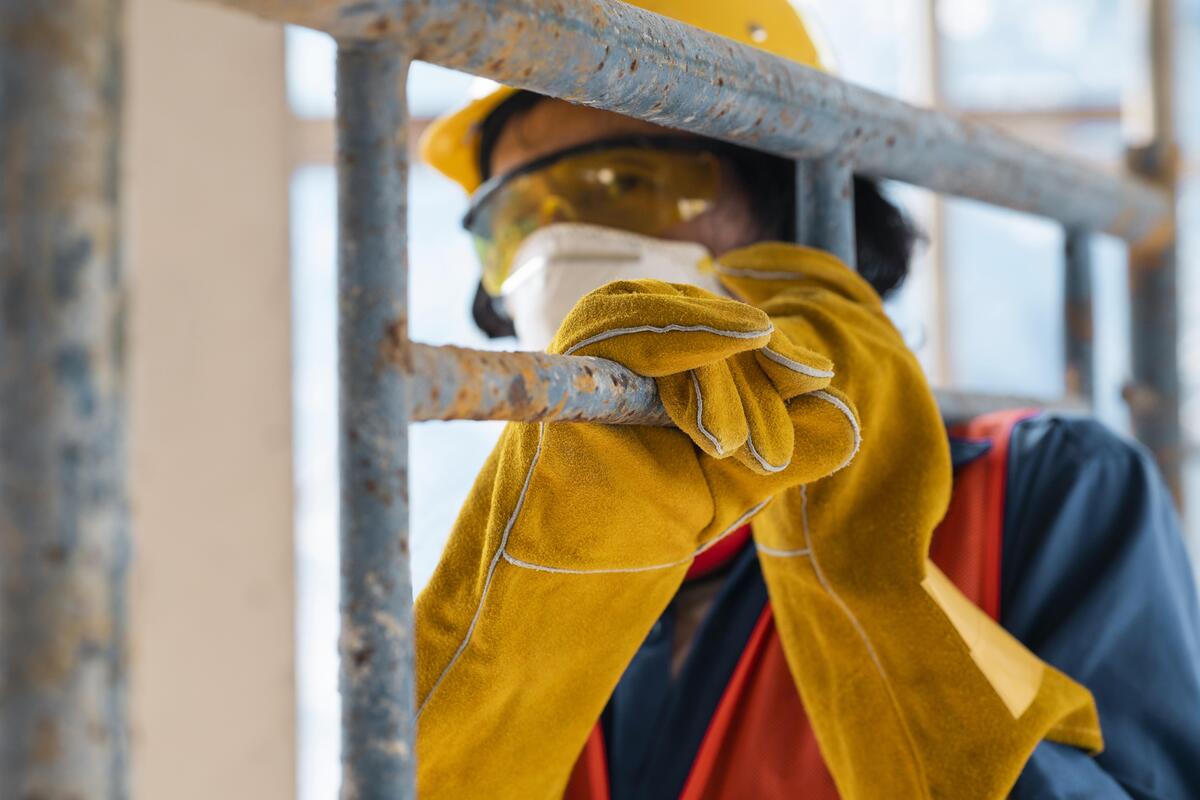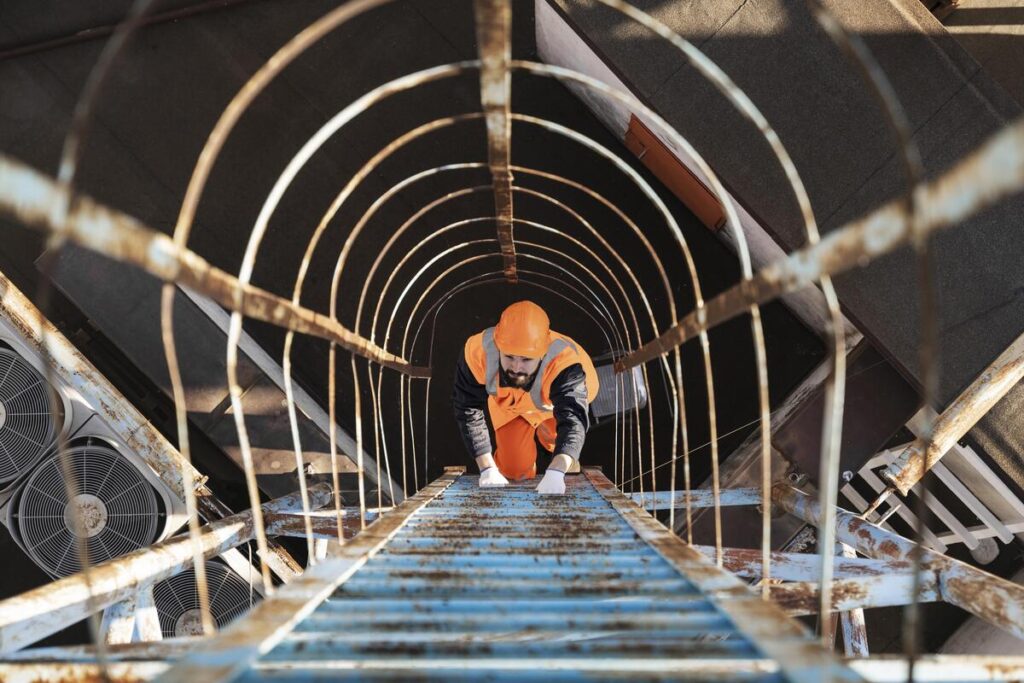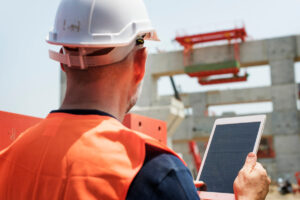Updated by Nazanin Ghodsian, 04/25/2025
Among the riskiest places to work are construction sites. Over 60,000 people worldwide lose their lives in construction-related disasters each year, according to the International Labour Organization (ILO), and millions more are injured or ill but do not die as a result. The most common causes of these deaths include falls, being struck by items, electrocution, and becoming trapped in or between things. The sector reported almost 205,000 non-fatal injuries in 2019 alone.
It’s critical to continuously improve safety measures on building sites in light of these threats. Employers and workers need to exercise caution, putting in place sensible safety precautions and donning the proper PPE. Consistent safety instruction and cognizance of possible risks are also necessary. Setting safety solutions as a top priority not only helps prevent accidents but also lowers overall costs, increases productivity, and minimizes downtime.
Encouraging worker participation and management support are key components of the continuous process of improving construction site safety. Construction sites may become safer places to work by putting these precautions in place, and employees can feel confident that their health and safety solutions come first.
Table of Contents
Why are Safety Solutions Important in Construction?
Nobody wants an employee to experience any form of injury while they are employed, particularly fatalities or seriously injured workers. However, it’s a basic fact that a lot of jobs are dangerous by nature. According to the most recent data, almost 4,700 American workers lost their lives while performing their jobs in 2020. According to federal OSHA construction safety data, approximately half of the workplace fatalities were related to construction, mining, transportation, and moving materials.
The National Safety Council (NSC) estimates that workplace injuries in the United States cost $167 billion in total in 2021. Supervisors are compelled to spend time looking into and reporting injuries, on top of medical expenses and time missed from work by covered employees. According to the NSC, treating injuries that need medical consultations costs $42,000 on average, while worker fatalities cost $1.34 million on average. Preventing accidents and fatalities can boost morale and productivity while drastically cutting expenses.
OSHA Safety Requirements for Construction
Certain employers express disapproval towards OSHA’s safety solutions for job sites and the actions taken by inspectors upon their arrival at a construction site. However, it’s hard to deny the federal workplace safety organization’s achievements in safeguarding American workers. Over its 50-year history, the average daily count of occupational fatalities has decreased from approximately 38 to 13. The number of sicknesses and injuries has drastically decreased, from 10.9 incidences per 100 workers to 2.7 events per 100.
Suggested article to read: Construction Safety Sensors; Guide to 2025
Construction Site Safety Solutions Checklist
Creating a building site safety solutions checklist is a good way to confirm that safety precautions have been taken. Better yet, checklists are a better way to continuously remind yourself of the importance of safe construction. Checklists reinforce safe work practices by making them routine and serve additional purposes. They cover everything from thinking about potential effects on the surrounding area to verifying PPE to inspecting tools. They also help you document your compliance with OSHA violation standards that construction companies are required to follow. Most importantly, though, checklists offer safety tips for construction workers.
Checklists should be specific to the project and its particular safety risks, just as no two construction sites are the same. After all, a key component of construction worker safety is their awareness of potential risks and how to mitigate them. A construction company’s safety strategy is put into action using checklists, which cover things like:
- Identification of hazards
- Essential Personal Protective Equipment
- Protection against falls
- Site sanitation
- Scaffolds and ladders
- Routes of emergency egress
- Safeguarding from fire
- Utilization and storage of tools
- Procedures for lockout/tagout
- Connections for utilities
- Staging and transferring materials
- Cutting and welding
30 Tips for Construction Safety Solutions
What is safety in construction? It’s a thorough procedure that involves evaluations, planning, and actions to safeguard the health and safety solutions of construction site workers as well as guard against harm to neighboring structures, machinery, and property. The main goals of construction site safety management are risk identification and mitigation. It is based on the understanding that the majority of accidents at work are avoidable. Serious injuries usually result from disregard for safety procedures and guidelines. Being aware of these building safety guidelines is a fantastic place to start.
1. Falls from Heights
Falling from heights is one of the most common safety hazards in construction. Neglecting to take necessary safety solutions when working on elevated surfaces might have disastrous results. A fall’s abrupt impact can cause spinal injuries, brain trauma, shattered bones, and even death.
Among the simplest safety solutions to stay clear of height-related risks are:
1. Utilize fall protection devices to prevent falls from heights and reduce the possibility of hitting the ground, such as safety nets, guardrails, and harnesses.
2. Make sure the elevated work platforms, ladders, and scaffolding are structurally sound by giving them regular inspections. Our supervisors at REDCOM visit the job sites several times a day to make sure the equipment is secure and safe.
3. Give employees enough instruction on working at heights. This covers identifying hazards, using personal protective equipment, and using safe climbing tactics.
2. Falling Objects
On a building site, things are always changing. Both labor and materials are constantly moving. A great deal of control is needed for this movement to guarantee that all goods are carried safely and kept. Unsecured and loose objects have the potential to fall and pose serious risks to worker safety solutions. Falling objects from high work areas have the potential to kill or seriously injure people. In the end, adopting all reasonable measures saves lives because variables like weight, height, and velocity can have unforeseeable results.
A few safety solutions to lessen the possibility of getting hurt by a falling object are:
4. When working at heights, appropriately secure tools and supplies to prevent worker drops.
5. Install safety nets or barricades to shield workers below from falling objects.
6. Assure that employees are always wearing the proper PPE, such as hard hats, to protect their heads. According to Donald Gumm, Lead Supervisor/Safety Officer at REDCOM, the most important requirement for construction site safety is “Appropriate PPE for everyone.”

3. Electrical Hazards
Electric shocks, burns, flames, and electrocution are just a few of the many occupational dangers that electricity can cause.
On construction sites, there can be a great deal of serious injuries or fatalities due to exposed wiring, malfunctioning machinery, and/or inappropriate handling of supplies and equipment. This kind of hazard is especially dangerous because electricity is unseen. Workers will remain safe at work and electricity will remain in the wires where it belongs when strong and thorough electrical safety procedures and standards are in place.
Occasionally, respected electrical safety solutions to follow are as follows:
7. To improve eye awareness, identify and label all electrical sources, including live cables and equipment. To further avoid mishaps, mandate that all guests and those who are not familiar with the work site always have a supervisor with them.
8. To prevent electrical shocks, use ground fault circuit interrupters.
9. Give appropriate instruction on electrical safety, stressing the value of lockout/tagout protocols and the usage of insulated tools to reduce the risk of shocks.
4. Trenching and Excavation Hazards
At construction sites, trenching and excavation provide a number of risks, including the possibility of cave-ins, falls, and exposure to hazardous materials. Additionally, dangerous incidents and even fatalities can result from unstable soil, insufficient safety measures, and inadequate ventilation.
On building projects, trenching and digging can be made safer in a few ways:
10. Before beginning any excavation, analyze the stability of the soil and adopt the appropriate safety measures, such as sloping or shoring the hole.
11. Install safety measures like trench boxes to stop collapses and cave-ins.
12. Maintain enough ventilation and conduct routine inspections to stop dangerous gas accumulation.
5. Hazardous Materials
Hazardous material handling, storage, and transportation safely reduce serious health hazards and environmental harm. On construction sites, hazardous materials such as chemicals, asbestos, lead-based paints, and other compounds can cause respiratory issues, poisoning, and long-term health consequences. Dangerous materials should not be handled, stored, or disposed of carelessly as this could expose local communities and employees by accident.
The following procedures are meant to keep employees safe when handling dangerous chemicals:
13. Make a thorough inventory and identify any hazardous materials that may be present on the property.
14. Educate people on how to handle, store, and get rid of dangerous materials.
15. Wear respirators, goggles, and gloves as personal protection equipment when handling dangerous products.
6. Heavy Machinery Accidents
Cranes, bulldozers, and forklifts are examples of heavy machinery that can seriously endanger both the operators and people working nearby. Events like entanglement, struck-by mishaps, or overturning machinery can be caused by improper operation, a lack of training, or technical malfunctions. In addition, the risks associated with construction sites are increased by the sheer size, weight, and power of heavy machines.
Considerations for machinery safety solutions:
16. Make that every operator has the necessary training and authorization to operate the apparatus.
17. Establish explicit guidelines for communication between workers and machinery operators.
18. To guarantee safe and dependable operation, regularly examine and maintain machinery. This includes looking for broken brakes, appropriate signs, and functional safety devices.
Suggested article to read: The Role of Climbing and Inspection Robots in Construction Safety; 2025 Guide
7. Slips, Trips, and Falls
Incidents involving slips, trips, and falls can result in injuries varying from little bumps to serious fractures and brain damage. On job sites, uneven surfaces, dirt, poor housekeeping, and insufficient lighting greatly enhance the risk of harm.
At construction sites, some safety solutions to avoid trips, slips, and falls are as follows:
19. Keep your workspaces tidy and orderly by clearing away any debris or obstructions that can lead to trips and falls.
20. Make sure all work locations have enough lighting to enhance visibility and lower the possibility of these kinds of mishaps.
21. Adopt routine housekeeping procedures to take care of spills, fallen objects, and other possible trip hazards right away.
8. Noise and Vibrations
Long-term exposure to high noise levels can result in hearing loss, and heavy mechanical vibrations can induce musculoskeletal ailments and weariness. These circumstances may hinder workers’ ability to focus, communicate, and move freely, which raises the risk of mistakes and accidents.
Several effective safety solutions to prevent noise and vibration concerns at construction sites include:
22. Give employees the correct hearing protection, such as earplugs or earmuffs, and see to it that they wear it as intended.
23. Measure the noise level frequently to determine which locations need noise reduction.
24. To lessen noise and vibrations, use technical controls like acoustic enclosures or sound barriers.
9. Heat and Cold Stress
On construction sites, workers run the risk of heat- and cold-related illnesses include heat exhaustion, heat stroke, hypothermia, and frostbite. Extreme temperatures can also cause exhaustion, dehydration, reduced cognitive function, and even organ failure among workers on construction sites. These risks are increased by the physically taxing nature of construction job.
Lead Supervisor/Safety Officer Donald Gumm of REDCOM says, “Heat exhaustion is rarely curable. It is worse to be hot than to be cold. Supervisors are educated to recognize the symptoms of heat exhaustion, manage it, and make sure that frequent breaks in the shade and with water are taken. Water cases in multiple sizes are provided for every trailer.
To avoid health problems associated with temperature:
25. In order to prevent heat-related illnesses during hot weather, provide frequent pauses in shaded or temperature-controlled settings.
26. Make certain that employees have access to enough water, and in both hot and cold climates, urge them to drink enough of it.
27. Provide suitable apparel in cold weather, such as gloves and insulated coats, to prevent cold stress.
10. Manual Handling and Ergonomic Hazards
Awkward postures, repetitive actions, and improper lifting techniques can cause sprains, strains, and persistent pain in the back and other joints.
Safety solutions like the ones mentioned below can help prevent these injuries:
28. Teach them how to lift correctly by bending at the knee and utilizing their legs rather than their backs.
29. When feasible, use mechanical assistance for heavy lifting, such as cranes or forklifts.
30. To avoid repeated motions and lessen strain on the body, ergonomic workspaces and instruments should be designed.

How to Improve Safety on Building Sites
There will always be health and safety hazards at work, and while it is impossible to completely eliminate all hazards, you can reduce the chance of getting hurt. This is especially true for construction work. When performing work in the construction sector, a thorough risk assessment, worker training, and safety procedures all work together to detect and reduce hazards.
Enhancing health and safety solutions on construction sites can be achieved by making sure that work is routinely observed. Enforcing this will stop employees from forming risky or potentially harmful habits that could result in an accident at work.
Be Consistent in Health & Safety Strategy
It is necessary to do a risk assessment and have health and safety solutions in place for any major building project. Ensuring that employees are aware of this strategy and can access it is the first step toward reducing workplace risk. Furthermore, as everyone should be able to recognize and comprehend the risks involved with particular tasks, it will also be beneficial to make sure that the information in the plan and how it is implemented into the project are consistent.
Worker Training
The first step in lowering workplace dangers in the construction sector is being able to identify and appropriately report problems. The second, and possibly most important, step is to teach your employees the appropriate response to possible threats when they materialize. Not only will your employees feel more appreciated if they are included in the health and safety solutions and plans, but it will also give them the chance to advance their skills.
Giving employees access to health and safety solutions is a wonderful approach to make sure they can recognize hazards and take appropriate action to address them in a safe and efficient manner.
The True Cost of Health & Safety Hazards
Health and safety issues at work carry a number of financial dangers in addition to the evident humanitarian ones. Absences from work might affect a job’s planned timetable and expected profitability. It will be more difficult to get skilled personnel if your organization has a history of using risky and hazardous business practices. Increased workers’ compensation claim volumes will drive up insurance costs, adding yet another unwelcome cost to your business. And while finishing a project on schedule is important, nothing is more important than your employees’ safety and well-being.
Conclusion
It can be risky to work on a building site, particularly if you don’t take the appropriate safety solutions. Working in construction is dangerous. Workers sustain workplace injuries on a daily basis. There are injuries that are not life-threatening and those that are. For the safety of construction workers, adherence to safety solutions is crucial. In this tutorial, we’ll cover eleven crucial building safety solutions.
It should come as no surprise that the top 10 OSHA infractions are similar to the Focus Four dangers In 2021, fall protection, ladders, and scaffolding were sixty percent of the most common violations. Contractors prioritize employee risks above everything else, but concerns about health and safety aren’t the only ones. In the event that unsafe work methods violate the conditions of the contract, there may be a breach of contract, delays in construction, and defense costs.
Although there are risks associated with working in construction, there are steps that may be taken to lower those risks. You must guarantee that your workers are following your safety policy to the letter and that they have access to the required safety gear and training. The likelihood of worker injuries can be decreased with the use of the aforementioned construction safety solutions.
FAQs
Why is Construction Site Safety Critical?
- Answer: Construction sites are known to be among the riskiest locations to work, as they frequently result in fatalities and injuries. Maintaining safety lowers expenses, avoids mishaps, and safeguards the health and welfare of employees.
What are the Primary Causes of Construction Site Accidents?
- Answer: In construction, falls, struck-by-object occurrences, electrocution, and caught-in-between accidents are the most common causes of death.
How can Construction Sites Improve Safety?
- Answer: It is crucial to put safety measures into place, offer personal protective equipment, carry out routine safety inspections, and guarantee appropriate worker training.
What Role does OSHA Play in Construction Safety?
- Answer: OSHA laws have greatly decreased workplace injuries and fatalities by establishing and enforcing safety measures.
What Should be Included in a Construction Safety Checklist?
- Answer: Identification of hazards, PPE needs, fall protection, tool inspections, site hygiene, and emergency protocols should all be included in a checklist.
Suggested article for reading:
Digital Transformation: The Role of 5G Technology in Construction
12 Cutting-Edge Technologies in Construction Automation You Need to Know
Sustainable Development Goals in Construction Industry; Guide 2025
Decarbonizing Construction; A Sustainable Future Ahead (2025 Solution)
Resources:
WatsonandWatsonSafety | Linkedin | HSEStudyGuide | HighSpeedTraining | ProCore | MyComplawyers | SafetyIQ | RedComllc | Hylant | SafetyCulture
For all the pictures: Freepik





